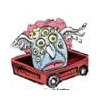Bloody Hot
New research indicates that when temperatures climb above 100 F, heat can cause restricted blood flow and boost heart attack risk.
In a study, volunteers wore special suits that slowly raised the surrounding temperature. All the participants experienced increased blood flow with more heat, a sign that their hearts were working harder, in part to cool their bodies.
Blood flow increased twice as much in the youngest, healthiest group compared to the oldest, least healthy group. One-third of that oldest, least healthy group -- seven out of 20 volunteers -- had blood flow blockages, despite feeling no angina symptoms during the experiment.
"Our hypothesis was that the reason why heat exposure might be bad is because it makes the heart work harder," study author Daniel Gagnon told STAT. "We didn't know to what extent does it work harder, and does it work sufficiently hard to think that it could lead to something, especially something like a heart attack."
Body of Knowledge
Everyone has a different number of taste buds, ranging from an average of 2,000 to 10,000. Taste buds are not limited to your tongue but also found in the roof and walls of your mouth, throat and esophagus. As you age, the number and sensitivity of your taste buds decline, helping to explain why foods that you don't like as a child become palatable to you as an adult or simply become less tasty and appealing.
Get Me That, Stat!
According to a newly published report by the Centers for Disease Control and Prevention, roughly 1.4 million unhoused people visited hospital emergency departments annually between 2016 and 2021. Most were between ages 26 and 64. Housed ED visitors tended to be older or younger than this range.
More unhoused people arrived at EDs by ambulance (42%) than those not unhoused (16%).
For more than half of unhoused people in the ED, Medicaid was the primary payer for care; less than 5% had private insurance. Medicaid was still the top source of payment for others at 34%, but 25% had private insurance.
Stories for the Waiting Room
For reasons of necessity (usually no medical help available), these folks all performed major surgery on themselves. Some possessed medical training, some did not. Sometimes things worked out, sometimes not so much.
1. Soviet explorer Leonid Rogozov successfully performed a self-appendectomy in 1961.
2. Australian veterinarian Robert Kerr McLaren did the same in a Filipino jungle in the 1940s -- without anesthesia.
3. U.S. Founding Father Gouverneur Morris (1752-1816) was suffering from a painful urinary blockage. He took a sliver of whalebone and attempted to physically clear the obstruction. A fatal penile infection resulted.
4. Kurtis Kaser was a Nebraska farmer whose leg got caught in a grain auger, a sort of spiral conveyor device. The auger began consuming his leg. Kaser used a pocketknife to sever the remains of his lower leg, then crawled to a telephone to call for help. He survived.
5. Ines Ramirez Perez was a 40-year-old pregnant woman living in a remote part of southern Mexico. In 2000, she went into labor. The nearest clinic was 50 miles away. After 12 hours of labor, Perez downed some hard liquor and used a 6-inch knife to perform a C-section on herself. She and the baby survived.
Doc Talk
Columella nasi: The fleshy end of the structure of bone and cartilage that separates your nostrils. You can see it just above the philtrum -- the vertical indentation in the middle area of the upper lip.
Mania of the Week
Ergomania: An obsession with work or exercise. To loosely paraphrase the Latin comment "cogito, ergo sum," attributed to Rene Descartes, "I think, therefore I work too much."
Best Medicine
A patient was asked to fill out a form before seeing the doctor.
After name and address, the form asked for "Nearest Relative."
The patient wrote, "walking distance."
Hypochondriac's Guide
Jargon aphasia is a type of language disorder in which an individual's speech is incomprehensible but appears to make sense to them. Expected words are replaced by illogical but similar-sounding substitutes or random sounds.
It is usually the result of traumatic brain injury, neurodegenerative disease and a penchant for running for political office.
Observation
"I was surprised when I started getting old. I always thought it was one of those things that would happen to someone else." -- American comedian George Carlin (1937-2008)
Medical History
This week in 1955, Ian Donald made his first investigation of the use of ultrasound in medical diagnosis. Working in the research department of the boilermakers Babcock and Wilcox at Renfrew, Scotland, Donald used an industrial ultrasonic metal flaw detector to image tumors from human organs.
He was familiar with sonar from his service in WWII and considered this to be a similar use of reflected sound to image the internal structure of the sample tissues. With other engineers, Donald refined the idea for clinical application. In 1958, he used ultrasound to diagnose a huge, easily removable ovarian cyst in a woman who doctors had concluded had inoperable stomach cancer.
Med School
Q: What is dyschronometria?
A: A brain dysfunction in which affected individuals cannot accurately estimate how much time has passed; also called distorted time perception. It is similar to other forms of dyslexia.
Epitaphs
"My brother was good at pissing people off." -- Headstone of Cecil O'Dell Eads (Dec. 14, 1934 - Sept. 4, 1993)
========
To find out more about Scott LaFee and read features by other Creators Syndicate writers and cartoonists, visit the Creators Syndicate website at www.creators.com.
Copyright 2024 Creators Syndicate Inc.









Comments